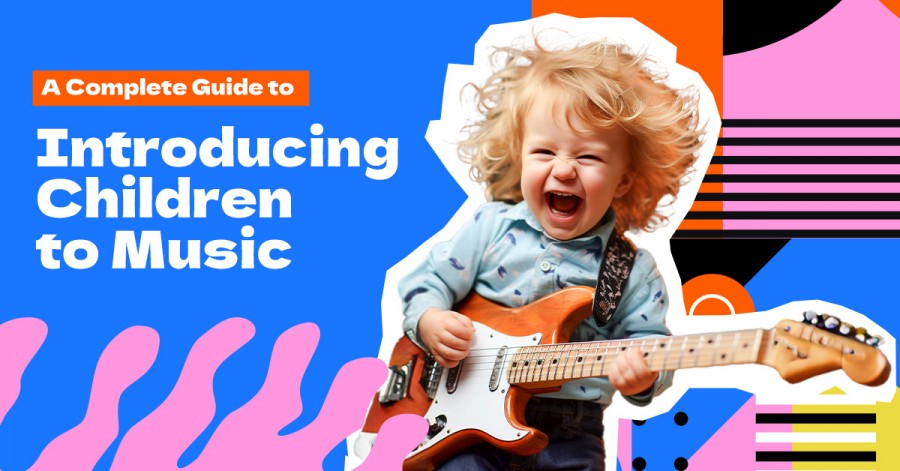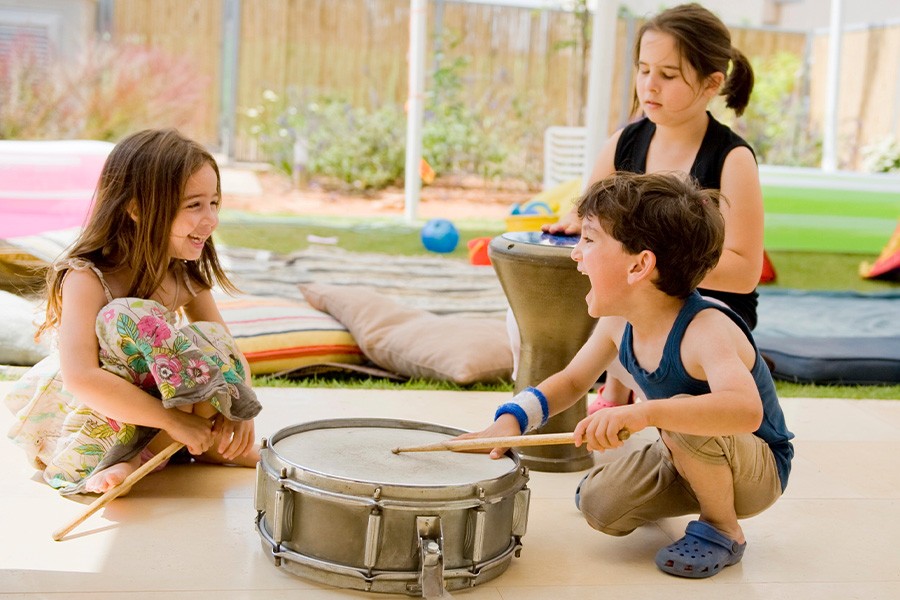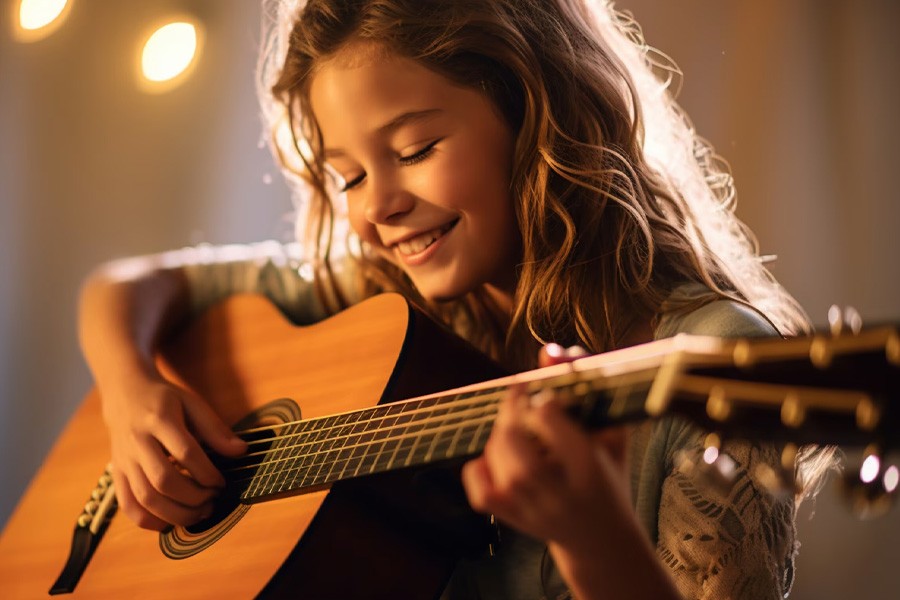A Complete Guide to Introducing Children to Music
Published 16 September 2024 at 10:08
Tickikids Blog Sharjah > A Complete Guide to Introducing Children to Music

Scientists have discovered that classical music positively influences plant growth, promoting faster development and increasing foliage. If harmonious sounds can have such an effect on plants, imagine the impact on humans! Even before birth, babies can recognise the voices of their parents, responding to different tones, volumes, and types of sounds. Pregnant women are often encouraged to speak, sing, or read aloud to their babies, as these early auditory experiences create a comforting environment. Once born, babies often find comfort in their mother’s lullabies and familiar sounds.
Check our Guide: Things to Do with Kids in Dubai
Experts in child development emphasise that music education should play a key role in a child’s overall development. Learning to play musical instruments boosts fine motor skills and stimulates both sides of the brain, while vocal training enhances breathing techniques and improves speech. Music lessons help expand a child’s horizons, enhance memory, and improve cognitive skills. Children who engage with music from an early age often display perseverance and determination, traits that help them excel academically.
Recent psychological research shows that music lessons or even just listening to music strengthens neural connections in the brain. Early music education has been linked to better coordination, which in turn improves emotional intelligence. This means that children who are exposed to music early on tend to handle frustration better, have more emotional control, and are less likely to develop attention disorders. Essentially, engaging with music “rewires” the brain, reinforcing or creating new neural pathways that benefit cognitive and emotional development.

Image Credit: Depositphotos
Start Early
Although learning music at any age is beneficial, the greatest impact is seen when children begin before age seven. Early exposure helps identify a child’s musical ear and vocal potential, setting the stage for future artistic growth. A child raised with quality music often stands out from their peers, showing creativity, a refined taste, and a rich perception of the world. Since young children tend to be active and have short attention spans, starting with musical toys or simple instruments like tambourines, mini xylophones, and maracas is ideal. These toys help children understand cause and effect, which is an important step in learning how to play instruments. Technology can also be a helpful tool in early music education. Music apps, online resources, and interactive platforms can supplement lessons with virtual keyboards, sing-alongs, and games that make learning fun and accessible.
Don't Miss Out: Our After-School Activities Guide
By age five, many children are ready to try playing simple melodies, and parents can then consider hiring a music teacher to nurture their budding talent. It’s important to follow the child’s lead and respect their interests, as true progress happens when they are genuinely motivated to learn. For beginners, it’s essential to choose instruments that match their skill level. Instruments like the piano, guitar, violin, flute, and drums offer a strong foundation in music theory and come in different sizes to suit young learners. Additionally, starting with more accessible instruments like the ukulele or xylophone can help build confidence. Ultimately, selecting instruments based on the child’s interests will foster a deeper connection with music and enhance their enjoyment and commitment to learning.
.jpg)
Image Credit: Depositphotos
Add a Melody to your Everyday Routines
Music offers a unique way to deepen your bond with children. Incorporating music into your child’s daily life can be a fun, educational, and emotionally rewarding experience. By creating a routine around singing and music, you not only enhance their developmental growth but also make special memories together!
Where to find songs? Classic songbooks like The Real Mother Goose or those focused on nursery rhymes are a great starting point. Services like Spotify, Apple Music, or YouTube have dedicated playlists for kids’ songs, ranging from educational tunes to fun sing-alongs. There are child-friendly apps like “KidzBop” or “Baby Shark” that provide curated collections of songs for different age groups. Platforms like “Super Simple Songs” or “Sesame Street” offer fun, educational music that’s perfect for young learners.
- Start the day with an upbeat song that gets everyone moving. Singing a song like “Good Morning to You” can make waking up more pleasant.
- Sing a song while preparing or setting the table, like “Pat-a-Cake” or “I’m a Little Teapot,” to keep them entertained during meal prep.
- During free play, let music play softly in the background!
- Use bathtime as an opportunity for fun water-themed songs, such as “Rubber Duckie” or “Splish Splash.”
- Encourage tidying up with a song like “Clean Up, Clean Up, Everybody Everywhere” to make chores more fun.
- Wind down the day with soothing lullabies like “Brahms’ Lullaby” or “Hush Little Baby” to calm and prepare for sleep.
Dancing is also a fun way to incorporate rhythm into their daily lives, and it keeps you both active while creating moments of joy and connection.You can also explore nature’s music! Take your child outside and encourage them to listen to the sounds of nature. Point out the rustling of leaves, birds chirping, or the wind blowing. Ask them to mimic these sounds or create a story around what they hear. Rain can be a wonderful opportunity to explore rhythm. Tap along to the rhythm of raindrops on windows or use it as inspiration to create your own rhythm with household objects.
Dedicate time each day for music, whether during breakfast, after school, or just before bedtime. Make it a part of different activities, like singing a song while getting dressed or while driving in the car. Switch up the songs regularly to keep things fresh and exciting for your child.
What to Expect in a Music Class
Most music classes for young children are highly interactive, combining singing, dancing, and playing simple instruments like shakers, tambourines, or drums. These activities help children connect with music in a hands-on way. Many classes encourage or require parents to participate alongside their children. This shared experience deepens the parent-child bond and creates a sense of security for the child as they explore new activities. Classes are typically structured by age groups, ensuring that activities are suited to the child’s developmental stage. Infants might focus on sensory experiences through soft sounds and rhythms, while toddlers engage in more active participation with singing, movement, and instrument play.
Repeating songs and routines helps children feel comfortable and understand the patterns in music. Familiar songs are often revisited to reinforce learning and build confidence. While the focus is on play and enjoyment, music classes subtly introduce concepts like rhythm, melody, and pitch.
You May Also Like: Arts and Crafts Classes
Create an exciting and nurturing learning space for your beginner music student! Ensure the class environment is welcoming and encourages children to express themselves freely, where mistakes are seen as part of the learning journey. When selecting a music teacher, choose someone who promotes open communication and values creativity. For young learners, it's important to include fun elements like educational games, musical puzzles, and hands-on activities to keep them engaged and make the learning experience enjoyable and interactive.

Image Credit: Freepik
Teaching Music with both Direction and Freedom
Introducing children to music with a guided yet flexible approach allows them to explore and develop their musical interests at their own pace while benefiting from structured guidance. This balanced method fosters creativity, keeps children engaged, and encourages them to enjoy music without feeling pressured.
- Allow children to engage with music in a way that feels natural to them. If they prefer banging on a drum rather than following a tune, that’s okay! The key is letting them interact with music in a way that sparks their interest.
- Children may want to create their own songs or rhythms. Encourage this improvisation, even if it seems random or disorganised. It’s a way for them to express themselves creatively and understand music in their own terms.
- If your child gravitates toward a particular instrument, song, or genre, encourage it. Letting them lead the way helps build their connection to music, keeping their enthusiasm alive.
- Provide a framework, such as daily or weekly music sessions, but keep the environment relaxed and playful. For example, have structured time to sing a few songs or explore an instrument, but leave space for them to experiment freely afterward.
- Music doesn’t need to be confined to specific lessons or activities. Let music happen naturally throughout the day—whether that’s singing while cooking, playing a rhythm while walking, or making up songs together during playtime. Some days, your child may be more focused and interested in following a song or learning a rhythm, while other days they might just want to dance or play freely. Adapt your approach to their mood, so they don’t feel forced into a rigid structure.
- Children benefit from repetition, which helps reinforce musical concepts. Keep a core set of songs or activities that they enjoy, and revisit them regularly to help build confidence and familiarity.
- Celebrate Small Wins! If your child masters a simple rhythm or learns the words to a song, celebrate that accomplishment. This boosts their confidence and keeps them motivated to continue exploring music.
- As your child grows, their musical preferences and abilities will change. Stay flexible in your approach, adapting to their evolving interests and skill levels. If they suddenly show interest in a new instrument or genre, be ready to explore that with them. Over time, as your child becomes more confident, give them more freedom to choose how they want to interact with music. This could mean playing alone, selecting their own songs, or even creating their own musical routines.
A guided yet flexible approach allows children to enjoy music on their own terms while providing the structure and encouragement they need to grow. By combining gentle instruction with plenty of space for creative exploration, you can nurture a lifelong love of music in a way that is enjoyable, empowering, and sustainable for your child.
Take your Little Ones to Experience Live Music
Visiting musical events is a wonderful way to introduce kids to the vibrant world of music. It not only creates memorable experiences but also exposes them to a wide variety of sounds, instruments, and musical styles that they might not encounter at home. Attending live music events—whether it’s a concert, a musical theatre production, or a cultural festival—introduces children to various music styles, from classical and jazz to folk and pop. This helps them develop an appreciation for different genres and instruments, expanding their musical palate.
Seeing instruments being played live is much more impactful than listening to recordings. Children can see how sounds are created, from the strumming of a guitar to the beating of a drum, making the connection between movement and music. Live music events highlight the communal aspect of music. Whether it’s a small group gathered for a local concert or a large audience at a festival, children see how music brings people together, creating a sense of belonging and shared enjoyment.
Introducing music to your children is a rewarding adventure that offers a multitude of benefits for their cognitive, emotional, and social improvement. By creating musical surroundings at home, undertaking fun and educational activities, exploring unique instruments, and incorporating music into day by day exercises, you may nurture a lifelong love for music in your kids. Consider exploring basic music classes or online training to further enhance their musical skills and reports. Embrace the pleasure of music collectively as a family and watch your kids thrive and grow into enthusiasts.
Related Articles: Useful Tips On How To Become A Great Musician